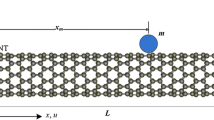Abstract
In this paper carbon nanotube (CNT) as a mass resonator sensor has been modelled by molecular structural mechanics approach. Then the effect of a single vacancy defect and its position on the sensing performances has been simulated. The simulation shows that the natural frequency shift of the cantileverd CNT, is decreased by the vacancy defect. Besides, when the vacancy gets nearer to the tip of the cantilevered CNT, its effect reduces. Simulations show that the effect of single vacancy defect on bridged CNT, in one-fourth of its length, is equal to the cantilevered one. Choosing smaller CNTs with smaller aspect ratios leads to having sensors with higher sensitivities. Simulations show that there are some positions in cantilevered and bridged CNTs that the effect of vacancy in frequency shift is negligible and the bridged CNTs are less sensitive than cantilevered CNTs to defects.










Similar content being viewed by others
References
Arghavan S, Singh AV (2011) On the vibrations of singlewalled carbon nanotubes. J Sound Vib 330:3102–3122
Banhart F (1999) Irradiation effects in carbon nanostructures. Rep Prog Phys 62:1181
Benes E, Groschl M, Burger W, Schmid M (1995) Sensors based on piezoelectric resonators. Sens Actuators A Phys 48:1–21
Chaste J, Eichler A, Moser J, Ceballos G, Rurali R, Bachtold A (2012) A nanomechanical mass sensor with yoctogram resolution. Nat Nano Technol 7:301–304
Chiu HY, Hung P, Postma HWC, Bockrath M (2008) Atomic-scale mass sensing using carbon nanotube resonators. Nano Lett 8:4342–4346
Chowdhury R, Adhikari S, Wang CY, Scarpa F (2010) A molecular mechanics approach for the vibration of singlewalled carbon nanotubes. Comput Mater Sci 48:730–735
Dai HJ, Hafner JH, Rinzler AG, Colbert DT, Smalley RE (1996) Nanotubes as nanoprobes in scanning probe microscopy. Nat (London) 384:147–150
Dresselhaus MS, Dresselhaus G, Jorio A (2004) Unusual properties and structure of carbon nanotubes. Annu Rev Mater Res 34:247–278
Duan WH, Wang CM, Zhang YY (2007) Calibration of nonlocal scaling effect parameter for free vibration of carbon nanotubes by molecular dynamics. J Appl Phys 101:024305
Georgantzinos SK, Anifantis NK (2009) Vibration analysis of multiwalled carbon nanotubes using a massspring based finite element model. Comput Mater Sci 47:168–177
Gibson RF, Ayorinde EO, Wen YF (2007) Vibrations of carbon nanotubes and their composites: A review. Compos Sci Technol 67:1–28
Hashemnia K, Farid M, Vatankhah R (2009) Vibrational analysis of carbon nanotubes and graphene sheets using molecular structural mechanics approach. Comput Mater Sci 47:79–85
Hauptmann P, Lucklum R, Puttmer A, Henning B (1998) Ultrasonic sensors for process monitoring and chemical analysis: state-of-the-art and trends. Sens Actuators A Phys 67:32–48
Hou W, Xiao S (2007) Mechanical behavior of carbon nanotubes with randomly located vacancy defects. J Nanosci Nanotechnol 7:4478–4485
Huang XMH, Zorman CA, Mehregany M, Roukes ML (2003) Nanoelectromechanical systems: nanodevice motion at microwave frequencies. Nat (London) 421:496–497
Iijima S et al (1992) Pentagons, heptagons and negative curvature in graphite microtubule growth. Nature 356:776–778
Ijima S (1991) Nature (London) 354:56–58
Joshi AY, Sharma SC, Harsha SP (2011) The effect of pinhole defect on vibrational characteristics of single walled carbon nanotube. Physica E 43:1040–1045
Kim P, Lieber CM (1999) Nanotube nanotweezers. Science 286(5447):2148–2150
Li CY, Chou TW (2004) Mass detection using carbon nanotube-based nanomechanical resonators. Appl Phys Lett 84:5246–5248
Li JJ, Jiang C, Chen B, Zhu KD (2012) Optical mass sensing with a carbon nanotube resonator. JOSA B 29:965–969
Lu C, Czanderna AW (2012) Applications of piezoelectric quartz crystal microbalances. Elsevier Publishers, Amsterdam
Mehdipour I, Barari A, Domairry G (2011) Application of a cantilevered SWCNT with mass at the tip as a nanomechanical sensor. Comput Mater Sci 50:1830–1833
Parvaneh V, Shariati M, Torabi H (2011) Frequency analysis of perfect and defective SWCNTs. Comput Mater Sci 50:2051–2056
Pirmoradian M, Ahmadian MT, Asempour A, Tajaui SA (2008) 3rd IEEE Int. Conf. on nano/micro engineered and molecular systems
Roth S, Baughman RH (2002) Actuators of individual carbon nanotubes. Curr Appl Phys 2:311–314
SakhaeePour A, Ahmadian MT, Vafai A (2009) Vibrational analysis of singlewalled carbon nanotubes using beam element. Thin Walled Struct 47:646–652
Thundat T, Oden PI, Warmack RJ (1999) Microscale Thermophys Eng (1999)
Tserpes KL, Papanikos P (2005) Composites
Wong EW, Sheehan PE, Lieber CM (1997) Nanobeam mechanics: elasticity, strength, and toughness of nanorods and nanotubes. Science 277:1971–1975
Zheng Q, Jiang Q (2002) Multiwalled carbon nanotubes as gigahertz oscillators. Phys Rev Lett 88:045503
Author information
Authors and Affiliations
Corresponding author
Rights and permissions
About this article
Cite this article
Gharaei, H., Nikfarjam, A., Saniei, F. et al. Simulation of CNT based mass resonator sensor and investigation on the effect of vacancy defect on sensing performances. Microsyst Technol 23, 2797–2805 (2017). https://doi.org/10.1007/s00542-016-3123-9
Received:
Accepted:
Published:
Issue Date:
DOI: https://doi.org/10.1007/s00542-016-3123-9




